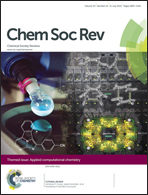Conceptual DFT: chemistry from the linear response function
Abstract
Within the context of reactivity descriptors known in conceptual DFT, the linear response function (χ(r,r′)) remained nearly unexploited. Although well known, in its time dependent form, in the solid state physics and time-dependent DFT communities the study of the “chemistry” present in the kernel was, until recently, relatively unexplored. The evaluation of the linear response function as such and its study in the time independent form are highlighted in the present review. On the fundamental side, the focus is on the approaches of increasing complexity to compute and represent χ(r,r′), its visualisation going from plots of the unintegrated χ(r,r′) to an atom condensed matrix. The study on atoms reveals its physical significance, retrieving atomic shell structure, while the results on molecules illustrate that a variety of chemical concepts are retrieved: inductive and mesomeric effects, electron delocalisation, aromaticity and anti-aromaticity, σ and π aromaticity,…. The applications show that the chemistry of aliphatic (saturated and unsaturated) chains, saturated and aromatic/anti-aromatic rings, organic, inorganic or metallic in nature, can be retrieved via the linear response function, including the variation of the electronic structure of the reagents along a reaction path. The connection of the linear response function with the concept of nearsightedness and the alchemical derivatives is also highlighted.

- This article is part of the themed collection: Applied Computational Chemistry

 Please wait while we load your content...
Please wait while we load your content...